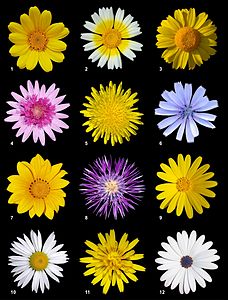What does asteraceae mean?
Definitions for asteraceae
aster·aceae
This dictionary definitions page includes all the possible meanings, example usage and translations of the word asteraceae.
Princeton's WordNet
Compositae, family Compositae, Asteraceae, family Asteraceae, aster familynoun
plants with heads composed of many florets: aster; daisy; dandelion; goldenrod; marigold; lettuces; ragweed; sunflower; thistle; zinnia
Wikipedia
Asteraceae
The family Asteraceae, alternatively Compositae, consists of over 32,000 known species of flowering plants in over 1,900 genera within the order Asterales. Commonly referred to as the aster, daisy, composite, or sunflower family, Compositae were first described in the year 1740. The number of species in Asteraceae is rivaled only by the Orchidaceae, and which is the larger family is unclear as the quantity of extant species in each family is unknown. Most species of Asteraceae are annual, biennial, or perennial herbaceous plants, but there are also shrubs, vines, and trees. The family has a widespread distribution, from subpolar to tropical regions, in a wide variety of habitats. Most occur in hot desert and cold or hot semi-desert climates, and they are found on every continent but Antarctica. The primary common characteristic is the existence of sometimes hundreds of tiny individual florets which are held together by protective involucres in flower heads, or more technically, capitula. The oldest known fossils are pollen grains from the Late Cretaceous (Campanian to Maastrichtian) of Antarctica, dated to c. 76–66 million years ago (mya). It is estimated that the crown group of Asteraceae evolved at least 85.9 mya (Late Cretaceous, Santonian) with a stem node age of 88–89 mya (Late Cretaceous, Coniacian). Asteraceae is an economically important family, providing food staples, garden plants, and herbal medicines. Species outside of their native ranges can be considered weedy or invasive.
Wikidata
Asteraceae
Asteraceae or Compositae, are an exceedingly large and widespread family of Angiospermae. The group has more than 23,000 currently accepted species, spread across 1,620 genera and 12 subfamilies. In terms of numbers of species, Asteraceae is rivaled only by Orchidaceae. The main feature of the family is the composite flower type in the form of capitula surrounded by involucral bracts.The name "Asteraceae" comes from Aster, the most prominent genus in the family, that derives from the Greek ἀστήρ meaning star, and is connected with its inflorescence star form. As for the term "Compositae", more ancient but still valid, it obviously makes reference to the fact that the family is one of the few angiosperms that have composite flowers. This family has a remarkable ecological and economical importance, and is present from the polar regions to the tropics, colonizing all available habitats. The Asteraceae may represent as much as 10% of autochthon flora in many regions of the world.
U.S. National Library of Medicine
Asteraceae
A large plant family of the order Asterales, subclass Asteridae, class Magnoliopsida. The family is also known as Compositae. Flower petals are joined near the base and stamens alternate with the corolla lobes. The common name of "daisy" refers to several genera of this family including Aster; CHRYSANTHEMUM; RUDBECKIA; TANACETUM.
Editors Contribution
ASTERACEAE
Asteraceae is the Latin name for the Daisy Family.
Daisies, artichokes and lettuce are all members of the genre of plants known as Asteraceae.
Etymology: New Latin - æstəˈreɪsi, aster-genre
Submitted by em844 on April 22, 2021
Matched Categories
Numerology
Chaldean Numerology
The numerical value of asteraceae in Chaldean Numerology is: 3
Pythagorean Numerology
The numerical value of asteraceae in Pythagorean Numerology is: 6
Popularity rank by frequency of use
Translations for asteraceae
From our Multilingual Translation Dictionary
Get even more translations for asteraceae »
Translation
Find a translation for the asteraceae definition in other languages:
Select another language:
- - Select -
- 简体中文 (Chinese - Simplified)
- 繁體中文 (Chinese - Traditional)
- Español (Spanish)
- Esperanto (Esperanto)
- 日本語 (Japanese)
- Português (Portuguese)
- Deutsch (German)
- العربية (Arabic)
- Français (French)
- Русский (Russian)
- ಕನ್ನಡ (Kannada)
- 한국어 (Korean)
- עברית (Hebrew)
- Gaeilge (Irish)
- Українська (Ukrainian)
- اردو (Urdu)
- Magyar (Hungarian)
- मानक हिन्दी (Hindi)
- Indonesia (Indonesian)
- Italiano (Italian)
- தமிழ் (Tamil)
- Türkçe (Turkish)
- తెలుగు (Telugu)
- ภาษาไทย (Thai)
- Tiếng Việt (Vietnamese)
- Čeština (Czech)
- Polski (Polish)
- Bahasa Indonesia (Indonesian)
- Românește (Romanian)
- Nederlands (Dutch)
- Ελληνικά (Greek)
- Latinum (Latin)
- Svenska (Swedish)
- Dansk (Danish)
- Suomi (Finnish)
- فارسی (Persian)
- ייִדיש (Yiddish)
- հայերեն (Armenian)
- Norsk (Norwegian)
- English (English)
Word of the Day
Would you like us to send you a FREE new word definition delivered to your inbox daily?
Citation
Use the citation below to add this definition to your bibliography:
Style:MLAChicagoAPA
"asteraceae." Definitions.net. STANDS4 LLC, 2024. Web. 8 May 2024. <https://www.definitions.net/definition/asteraceae>.



Discuss these asteraceae definitions with the community:
Report Comment
We're doing our best to make sure our content is useful, accurate and safe.
If by any chance you spot an inappropriate comment while navigating through our website please use this form to let us know, and we'll take care of it shortly.
Attachment
You need to be logged in to favorite.
Log In